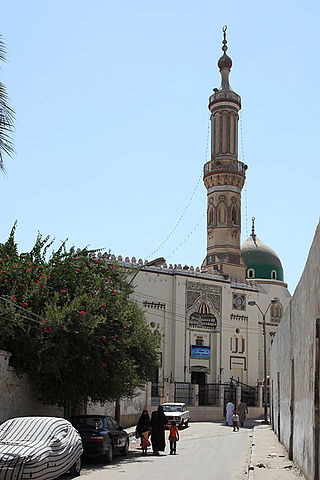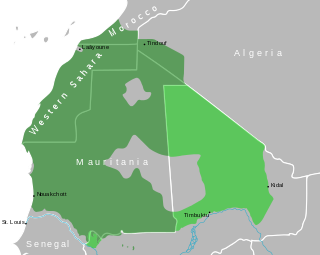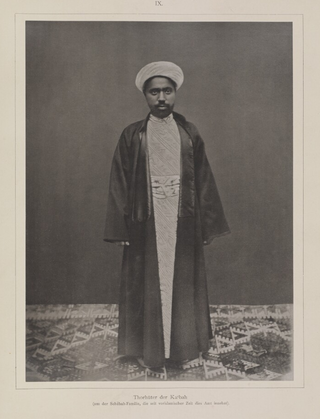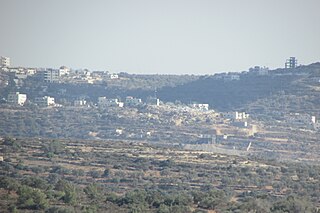
Beni Suef is one of the governorates of Egypt. It is situated in the center of the country and it’s located in northern Upper Egypt.

Beni Suef is the capital city of the Beni Suef Governorate in Egypt. Beni Suef is the location of Beni Suef University. An important agricultural trade centre on the west bank of the Nile River, the city is located 110 km south of Cairo.

Beni Ḥassan is a Bedouin Arab tribe which inhabits Western Sahara, Mauritania, Morocco and Algeria. It is one of the four sub-tribes of the Beni Maqil who emigrated in the 11th century from South Arabia to the Maghreb with the Bani Hilal and Banu Sulaym Arab tribes. In the 13th century, they took the Sanhaja territories in the southwest of the Sahara. In Morocco, they first settled, alongside their Maqil relatives, in the area between Tadla and the Moulouya River. The Sous Almohad governor called upon them for help against a rebellion in the Sous, and they resettled in and around that region. They later moved to Mauritania, and from the 16th century onwards, they managed to push back all black Mauritanians southwards to the Senegal Valley river. The Beni Hassan and other warrior Arab tribes dominated the Sanhaja Berber tribes of the area after the Char Bouba war of the 17th century. As a result, Arabs became the dominant ethnic group in Western Sahara and Mauretania. The Bani Hassan dialect of Arabic became used in the region and is still spoken, in the form of Hassaniya Arabic. The hierarchy established by the Beni Hassan tribe gave Mauritania much of its sociological character. That ideology has led to oppression, discrimination and even enslavement of other groups in Mauritania.

The Hammadid dynasty was a branch of the Sanhaja Berber dynasty that ruled an area roughly corresponding to north-eastern modern Algeria between 1008 and 1152. The state reached its peak under Nasir ibn Alnas during which it was briefly the most important state in Northwest Africa. Its realm was conquered by the Almohad Caliphate.

The Beni Sakhar confederacy is one of the largest and most influential tribal confederacies in Jordan. Its founder, Sakher bin Tha'labah al Tayy likely lived in the 3rd century AD, making the tribe around 18 centuries old. The Bani Sakher began migrating to Jordan as early as the 16th century and grew to become an influential tribe as by around the mid 18th century. The Beni Sakher is made out of many clans, both through ancestry and alliances. These clans are primarily separated into three groups, Al-Twaqa headed by the princely Al-Fayez family, Al-Ka'abneh headed by the Khreisha family, and Al-Khdeir.

The Bani Shaiba are an Arab clan belonging to the Banu Abd al-Dar sub-clan, that are part of the larger erstwhile Quraysh tribal confederation in Hejaz, present-day Saudi Arabia. They comprise mainly of the descendants of Uthman ibn Talha, his father Talha ibn Abdullah and his grandfather Abd al-Dar ibn Qusai and are known to have historically held the keys to the Kaaba since pre-Islamic era, and subsequently in the aftermath of the Conquest of Mecca by the Islamic prophet Muhammad in 630.
Bani Suheila is a municipality in the Gaza Strip, in the Khan Yunis Governorate of the State of Palestine. The town is located 2 km (1.2 mi) east of the city of Khan Younis. As of 2017, Bani Suheila had a population of 41,439 people.
Kafr Ein is a Palestinian village in the Ramallah and al-Bireh Governorate, located northwest of Ramallah in the central West Bank. According to the Palestinian Central Bureau of Statistics (PCBS), Kafr Ein had a population of 1,958 inhabitants in 2017. Most of the village's population comes from the Barghouti, Rifa' and Rafati clans.

Qarawat Bani Zeid is a Palestinian village in the Ramallah and al-Bireh Governorate, located 22 kilometers northwest of Ramallah in the northern West Bank. According to the Palestinian Central Bureau of Statistics (PCBS), Qarawat Bani Zeid had a population of 3,415 inhabitants in 2017. Almost all of Qarawat Bani Zeid is under the complete control of the Palestinian National Authority, as it is located within Area A.

Majdal Bani Fadil is a Palestinian town in the Nablus Governorate of the State of Palestine in the northern West Bank, located 23 kilometers (14 mi) southeast of Nablus. According to the Palestinian Central Bureau of Statistics (PCBS), the town had a population of 2,907 inhabitants in 2017.

Banu Hudhayl is an Arab tribe that originated in the Hejaz. The tribe mainly inhabits Saudi Arabia, Tunisia, Jordan and Egypt. The tribe was one of the tribes in contact with the Islamic prophet Muhammad and they are known throughout history for their talented poets and intellectuals.

Al-Mazra'a al-Qibliya is a Palestinian village in the Ramallah and al-Bireh Governorate. The village had a population of 5,180 in 2017.
Béni Khalled is a town and commune in the west of Nabeul Governorate, Tunisia, about 42 km from the capital Tunis. As of 2004 it had a population of 12,573. Béni Khalled is considered an important agricultural town in the region due to its citrus fruit production; it contributes by about 45% of the total of the national export. It also produces a high percentage of multiple strategic crops including grapes, potatoes and spices as well as raising livestock, milk production and beekeeping. The municipal area covers around 600 ha.
Beni Khedache is a town and commune in Médenine Governorate, Tunisia. It had a population of 3,071 as of 2004. It lies between Jebel Dahar and the Grand Erg Oriental, roughly 30 kilometres (19 mi) west of Médenine. It is home to a subterranean mosque.

Benis is a rural village in Guney-ye Sharqi Rural District, in the Central District of Shabestar County, East Azerbaijan Province, Iran.

Usman bin Yahya, Utsman ibn Yahya or Othman bin Yahya was an Islamic scholar who served as Grand Mufti of Batavia in 19th century of Dutch East Indies.

Bani 'Amir is an Arab tribe in Morocco, descended from Banu Hilal. It mainly inhabits the Hilali city Fquih Ben Salah and the surrounding areas in the Tadla tribal confederation. Bani 'Amir settled in Morocco in the 12th century during the reign of Almohad caliph Abd al-Mu'min.

El Brij, is a village of Tunisia, at latitude 36°48'13.44" and Longitude 10°36'8.95" on the Cape Bon peninsula near the village of Sidi Rais and Korbous. Surrounded by the Qorbus Forest and with access to beaches for the residents of Carthage, the area has been popular as a health resort since Roman times.
Sidi Raïs is a village and locality on Cape Bon in Tunisia.














